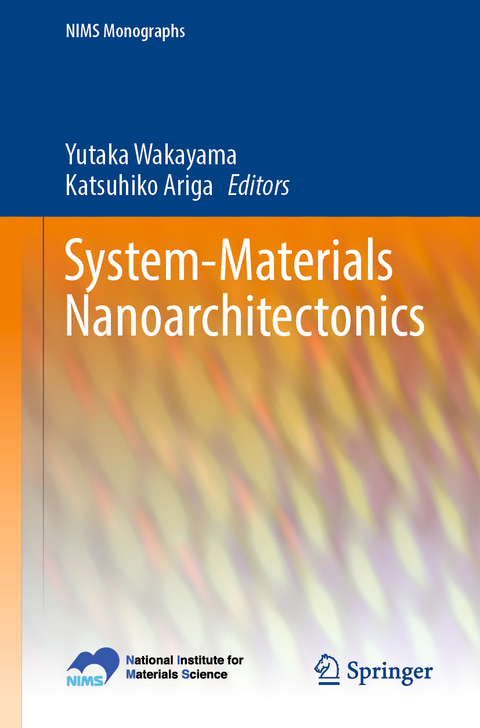
System-Materials Nanoarchitectonics
Springer Verlag, Japan
978-4-431-56911-4 (ISBN)
Yutaka Wakayama (National Institute for Materials Science) Yutaka Wakayama received his PhD degree from University of Tsukuba on 1998. He is currently the leader of Quantum Device Engineering Group of World Premier International (WPI) Research Centre for Materials Nanoarchitectonics (MANA), the National Institute for Materials Science (NIMS). His research is oriented to fundamental studies on molecular assemblies in various dimensions and their application to optoelectronic devices: crystalline and electronic structure of molecular superlattice, carrier transport through directed- and self-assembled molecular wires, STM study on two-dimensional supermolecules, molecular quantum dot for single-electron devices, and advanced functional organic field-effect transistors. He has been appointed as a professor of Kyushu University since 2009. Katsuhiko Ariga (National Institute for Materials Science, The University of Tokyo) World Premier International (WPI) Research Center for Materials Nanoarchitectonics (MANA), National Institute for Materials Science (NIMS), 1-1 Namiki, Tsukuba, Ibaraki 305-0044, Japan Katsuhiko Ariga received his PhD degree from Tokyo Institute of Technology. He is currently the Director of Supermolecules Group and Principal Investigator of World Premier International (WPI) Research Centre for Materials Nanoarchitectonics (MANA), the National Institute for Materials Science (NIMS). His research is oriented to supramolecular chemistry, surface science, and functional nanomaterials (Lanmguir-Blodgett film, layer-by-layer assembly, self-organized materials, sensing & drug delivery, molecular recognition, mesoporous material etc.) and is now trying to combine them into unified field for world-surprise. He is editors and editorial advisory members of ca. 20 scientific journals. He is Fellow of Royal Societ of Chemistry, Nice-Step Reseracher (2010), Highly Cited Reseracher, and a member of World Economic Forum Expert Network. Since 2017, he is also appointed as a professor of The University of Tokyo.
What is Nanoarchitectonics?.- Synthesis of Semiconductor Nanowires.- Nanoparticle Biomarkers Adapted for Near-Infrared Fluorescence Imaging.- Frontiers in Mesoscale Materials Design.- Wavelengh-selective Photothermal Infrared Sensors.- Functional Molecular Liquids.- Ionic nanoarchitectonics: Creation of polymer-based atomic switch and decision-making device.- Oxoporphyrinogens: Novel Dyes based on the Fusion of Calix[4]pyrrole, Quinonoids and Porphyrins.- Growth and electronic and optoelectronic applications of surface oxides on atomically thin WSe2.- Portable toxic gas sensors based on functionalized carbon nanotubes.- Advanced Nanomechanical Sensor for Artificial Olfactory System: Membrane-type Surface Stress Sensor (MSS).- Quantum Molecular Devices toward Large-Scale Integration.- Nanostructured bulk thermoelectric materials for energy harvesting.- Artificial Photosynthesis: Fundamentals, Challenges, and Strategies.- Smart Polymers for Biomedical Applications.- Geometrical andmechanical nanoarchitectonics at interfaces bridging molecules with cell phenotypes.- Electrical measurement by Multiple-Probe Scanning Probe Microscope.- Large-Scale First-principles Calculation Technique for Nanoarchitectonics: Local orbital and Linear-scaling DFT methods with the CONQUEST code.- Machine Learning Approaches in Nanoarchitectonics.
| Erscheinungsdatum | 07.01.2022 |
|---|---|
| Reihe/Serie | NIMS Monographs |
| Zusatzinfo | 157 Illustrations, color; 12 Illustrations, black and white; IX, 338 p. 169 illus., 157 illus. in color. |
| Verlagsort | Tokyo |
| Sprache | englisch |
| Maße | 155 x 235 mm |
| Themenwelt | Naturwissenschaften ► Chemie ► Organische Chemie |
| Technik ► Maschinenbau | |
| Schlagworte | device nanotechnology • Emerging Nanotechnology • Functional Nanomaterials • Nanoarchitectonics • Nanoarchitecture • Nanomaterials for Energy and Life |
| ISBN-10 | 4-431-56911-1 / 4431569111 |
| ISBN-13 | 978-4-431-56911-4 / 9784431569114 |
| Zustand | Neuware |
| Informationen gemäß Produktsicherheitsverordnung (GPSR) | |
| Haben Sie eine Frage zum Produkt? |
aus dem Bereich


